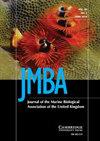亚热带西南大西洋沿岸浮游动物群落结构
IF 0.9
4区 生物学
Q3 MARINE & FRESHWATER BIOLOGY
Journal of the Marine Biological Association of the United Kingdom
Pub Date : 2023-07-06
DOI:10.1017/S0025315423000358
引用次数: 0
摘要
摘要对西南大西洋(乌拉圭,34°23′s - 53°45′w)沿海海洋站的浮游动物群落结构(物种丰度、生物量和多样性)进行了调查。这是西南大西洋亚热带辐合带的一个水文复杂的地点,对微型浮游动物的了解特别少。主要目标是对该群落进行首次表征,并评估其与年度周期的环境驱动因素的关系。从2019年7月至2020年6月,每月记录海洋变量(温度、盐度、辐照度、营养物质、叶绿素-a)和纤毛虫(矽酸盐和矽酸盐)和鞭毛藻。已鉴定出100多个小型浮游动物类群,隶属于约30科40属,其中包括若干亚热带和亚南极物种。群落结构在季节尺度上发生了广泛的转变,特别是在夏季和冬季之间,亚热带分类群与来自较冷的亚南极水域的泛盐分类群交替存在。核心环境变量(温度、盐度和溶解无机氮[DIN])解释了微型浮游动物群落组合的总体差异。在夏季,高温(20.3,16.3-22.4°C)和低营养(DIN: 3.5, 0.7-6.7 μM;PO4: 1.0、0.8 ~ 1.5 μM)有利于无钙纤毛虫的发育。冬季的营养脉冲形成了有利的化学计量条件,在接下来的几个月里,数量丰度以鞭毛虫和门酸纤毛虫为主,而多样性保持最高(分类丰富度:36 [22-46];Shannon-Wiener指数:2.5[1.9-2.8])。结果表明,研究地点的微型浮游动物群落主要由与近海水体的季节性更替有关的水文变化和局部过程组成,这些变化与温盐性质和营养水平的差异有关。本文章由计算机程序翻译,如有差异,请以英文原文为准。
Microzooplankton community structure in a subtropical South-West Atlantic coastal site
Abstract The microzooplankton community structure (species abundance, biomass, diversity) was investigated at a coastal marine station on the South-West Atlantic Ocean (34°23′S–53°45′W, Uruguay). This is a hydrographically complex site within the Subtropical Convergence zone of the SW Atlantic where knowledge of the microzooplankton is particularly scant. The main goal was to perform a first characterization of that community and evaluate its association to environmental drivers along an annual cycle. Oceanographic variables (temperature, salinity, irradiance, nutrients, chlorophyll-a) and ciliates (aloricate and loricate), and dinoflagellates were recorded monthly from July 2019 to June 2020. Over 100 microzooplankton taxa belonging to approximately 30 families and 40 genera were identified, including several subtropical and subantarctic species. Community structure followed wide transitions at the seasonal scale – particularly between summer and winter as subtropical taxa alternated with euryhaline taxa from colder subantarctic waters. The core environmental variables (temperature, salinity and dissolved inorganic nitrogen [DIN]) explained overall variance in microzooplankton community assembly. During summer, high temperatures (20.3, 16.3–22.4°C) and low nutrients (DIN: 3.5, 0.7–6.7 μM; PO4: 1.0, 0.8–1.5 μM) benefited the development of aloricate ciliates. A nutrient pulse in winter posed favourable stoichiometric conditions and the numerical abundance was dominated by dinoflagellates and loricate ciliates in the following months, while diversity remained highest (taxonomic richness: 36 [22–46]; Shannon–Wiener index: 2.5 [1.9–2.8]). Results suggested that the microzooplankton community at the study site is mainly structured by hydrographic variability linked to the seasonal replacement of offshore water masses that differed in thermohaline properties and nutrient levels, and local processes.
求助全文
通过发布文献求助,成功后即可免费获取论文全文。
去求助
来源期刊
CiteScore
2.30
自引率
8.30%
发文量
68
审稿时长
3-8 weeks
期刊介绍:
JMBA is an international journal, publishing original research on all aspects of marine biology. It includes pioneering work taking place today on major issues concerning marine organisms and their environment. Subjects covered include: ecological surveys and population studies of marine communities; physiology and experimental biology; taxonomy, morphology and life history of marine animals and plants; and chemical and physical oceanographic work. Included with 2010 online subscriptions: Marine Biodiversity Records.

 求助内容:
求助内容: 应助结果提醒方式:
应助结果提醒方式:


